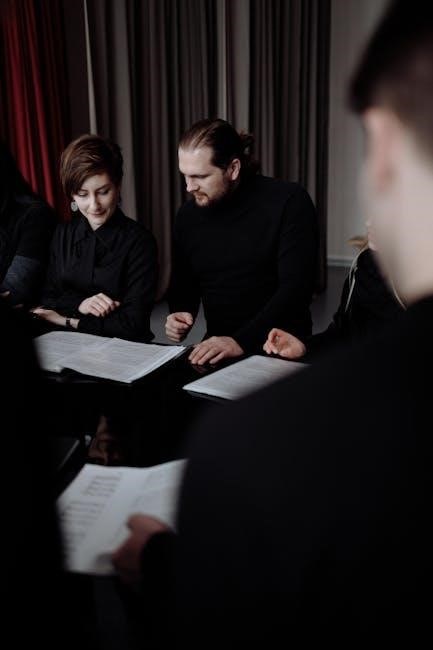
vocal sight reading exercises pdf
Vocal sight reading is the ability to sing unfamiliar music flawlessly upon first encounter. It is an essential skill for professional vocalists and students alike, enhancing pitch accuracy and rhythmic precision. Resources like the CHAOS method, Trinity College London examples, and NYSSMA guidelines provide structured approaches to mastering this technique. Regular practice builds confidence and mastery.
1.1 What is Vocal Sight Reading?
Vocal sight reading is the skill of singing unfamiliar musical notation accurately and expressively upon first encounter. It involves interpreting pitch, rhythm, and dynamics without prior practice, enhancing musical literacy and adaptability. This technique is crucial for vocalists, enabling quick mastery of new repertoire and fostering confidence in performances and auditions. Regular practice with exercises tailored to vocal ranges and skill levels helps refine this ability and ensures polished delivery of complex compositions.
1.2 Importance of Sight Reading for Vocalists
Sight reading is crucial for a successful vocal career, enhancing confidence and reducing performance anxiety. It improves pitch accuracy, rhythmic precision, and overall musicality. By mastering sight reading, vocalists can quickly adapt to new repertoire, collaborate effectively, and excel in auditions. Regular practice with exercises from resources like NYSSMA Level II and Trinity College examples helps refine these skills, ensuring polished deliveries and fostering artistic growth.

Basic Exercises for Vocal Sight Reading
Begin with simple melodic patterns in C Major, clapping or chanting rhythms, and singing exercises backward to build foundational skills. Start slow, focus on accuracy, and progress gradually.
2.1 Simple Melodic Patterns in C Major
Start with Do-Re-Mi-Fa-Sol-La-Ti-Do in C Major. Use exercises focusing on stepwise motion and common intervals. Play I, V, I chords to establish tonality. Read exercises mentally first, then sing. Clap or chant rhythms before adding pitch names. Gradually increase tempo as confidence grows. This method ensures a solid foundation for more complex sight reading tasks, enhancing both pitch recognition and rhythmic accuracy effectively.
2.2 Clapping and Chanting Rhythms
Clapping and chanting rhythms are fundamental to vocal sight reading. Start by clapping basic patterns, then chant pitch names or solfege syllables. This approach helps develop timing and rhythmic accuracy. Begin with simple exercises, such as quarter notes and eighth notes, and gradually introduce syncopation and dotted rhythms. Chanting strengthens the connection between sight and sound, preparing the voice for more complex melodic patterns and enhancing overall musicality.

Advanced Sight Reading Techniques
Advanced techniques refine skills through complex exercises. Methods like singing backwards and using solfege enhance accuracy. Trinity College examples and the CHAOS method provide structured challenges, expanding vocal versatility.
3.1 Singing Exercises Backwards
Singing exercises backward is an advanced technique to enhance sight-reading skills. It involves reversing the order of notes and rhythms, improving pitch recognition and control. By practicing this method, singers gain a deeper understanding of musical structure. This exercise doubles the effectiveness of practice, boosting confidence and accuracy. It is particularly recommended for mastering complex melodic patterns and ensuring precise execution during performances.
3.2 Using Solfege for Better Pitch Accuracy
Solfege is a powerful tool for improving pitch accuracy in vocal sight reading. By assigning syllables like “Do,” “Re,” “Mi,” “Fa,” “Sol,” “La,” and “Ti” to specific pitches, singers can internalize musical scales and intervals. This method enhances pitch recognition, allowing for more precise and confident sight singing. Regular solfege exercises, especially in treble clef, strengthen tonal awareness and are widely recommended in vocal training programs and resources.
Sight Reading Methods and Resources

This section explores effective methods and resources for vocal sight reading, including the CHAOS method and Trinity College London examples, aiding in skill development.
4.1 The CHAOS Method for Sight Reading
The CHAOS method is a structured approach to sight reading, emphasizing independence and normal tempo singing. It involves playing I, V, and I chords to establish tonality and mentally rehearsing exercises. Singing backwards doubles practice effectiveness, boosting confidence and proficiency. This method is widely used in vocal training to enhance pitch accuracy and rhythm skills, making it a valuable tool for all vocalists.
4.2 Trinity College London Sight Reading Examples
Trinity College London offers comprehensive sight reading examples for vocalists, particularly for Grades 6-8. These exercises include accompanied sight reading, focusing on pitch accuracy and rhythm. Designed for practical exams, they cover various vocal ranges and styles. The examples are available on the Trinity College London website, providing valuable resources for singers to refine their sight reading skills and prepare for assessments effectively.

Sight Reading for Specific Vocal Ranges
This section provides exercises tailored to specific vocal ranges, such as soprano and three-part male (TTB) arrangements. It includes samples like SW SR Soprano I and II.
5.1 Soprano Sight Reading Samples
Explore soprano-specific exercises, such as SW SR Soprano I (2007 1, 2, 3) and Soprano II (2007 1). These samples focus on C major scales, clapping rhythms, and chanting pitches. Designed to enhance accuracy and range, they align with methods like CHAOS and NYSSMA guidelines, offering structured practice for soprano vocalists to refine their sight-reading skills effectively.
5.2 Three-Part Male Exercises (TTB)
Engage with three-part male exercises tailored for Tenor (T) and Bass (B) voices. These exercises focus on synchronization and harmonic balance, often using diatonic steps and syncopated rhythms. Men singing the middle part can adapt to either the second or third line. Regular practice enhances blend and accuracy, supporting both individual and ensemble performance, essential for male vocalists aiming to refine their sight-reading proficiency.

Rhythmic and Tonal Patterns
Mastering rhythmic and tonal patterns begins with simple melodic exercises in C Major. Use solfege for pitch accuracy and incorporate syncopation and dotted rhythms for advanced practice.
6.1 Diatonic Steps and Progressive Sight Singing
Diatonic steps involve singing scales within a key, improving pitch recognition. Progressive sight singing introduces complex melodies gradually, fostering fluency. Start with C Major exercises, clapping rhythms, and chanting pitches. Use solfege for accuracy and expand to syncopation. Regular practice with click tracks enhances timing. Trinity College examples and NYSSMA guidelines provide structured exercises, ensuring a smooth transition from basic to advanced techniques effectively.
6.2 Syncopation and Dotted Rhythms
Mastering syncopation and dotted rhythms enhances rhythmic accuracy in sight reading. Start by clapping or chanting complex patterns, focusing on offbeat accents and longer note values. Use exercises from Trinity College London examples to practice these rhythms. The CHAOS method encourages singing independently, while resources like NYSSMA guidelines offer structured drills. Regular practice with click tracks improves timing and fluency in advanced vocal sight reading exercises.

Practice Tips and Tools
Enhance your practice with a click track for precise timing and interactive software like Choraltech Inc. These tools improve rhythm and engage singers effectively.
7.1 Using a Click Track for Timing
A click track is a valuable tool for improving timing in vocal sight reading. It provides a steady tempo, helping singers maintain consistent rhythm. Start by clapping or chanting the rhythm with the click track before singing. This method enhances accuracy, especially with complex time signatures. As confidence grows, singers can focus on pitch and dynamics while the click track guides their timing, ensuring a polished performance.
7.2 Interactive Sight Singing Software
Interactive software offers dynamic tools for vocal sight reading practice. Programs like Choraltech Inc. provide sequenced exercises, starting with basic concepts and progressing to advanced techniques. These tools allow singers to practice at their own pace, offering immediate feedback on pitch and rhythm accuracy. They also include features for looping difficult sections and adjusting tempos, making them ideal for both students and professionals to refine their skills effectively.
Sight Reading in Auditions and Exams
Sight reading is crucial in auditions and exams, often starting on “Do.” Trinity College London provides structured examples, ensuring singers are prepared for diverse musical challenges effectively.
8.1 NYSSMA Level II Sight Reading Guidelines
NYSSMA Level II sight reading evaluates pitch accuracy, rhythm, and articulation. Exercises start on “Do” and use C, F, or G. Students should clap or chant rhythms before singing. The range is limited between Do and La, focusing on diatonic steps. Practice with a click track aids timing. Regular drills build confidence for flawless performances in auditions and exams.
8.2 Preparing for Sight Reading Auditions
Preparing for sight reading auditions involves mastering tonality and rhythm. Start with exercises in C Major, using tools like the CHAOS method. Practice solfege for pitch accuracy and clap rhythms before singing. Use interactive software for drills. Begin with slow tempos and gradually increase speed. Mental rehearsal and breathing techniques reduce nerves. Focus on articulation and dynamics to ensure a confident, polished performance.
Additional Resources and Exercises
Explore Trinity College London examples, NYSSMA guidelines, and interactive software like Choraltech Inc. for diverse exercises. Elementary school rhythmic drills and high school multi-part singing (e.g., TTB) enhance skills. Utilize solfege exercises, sight-singing PDFs, and progressive sight singing for comprehensive practice.
9.1 Elementary School Rhythmic Exercises
Elementary school rhythmic exercises focus on basic patterns like quarter notes, half notes, and eighth notes. Students clap or chant rhythms before singing, using visual aids like flashcards. Simple exercises in C Major introduce pitch recognition. Progressive drills build timing accuracy and confidence. These foundational activities prepare young vocalists for more complex sight-reading challenges, fostering a strong musical understanding and enjoyment.
9.2 High School Multi-Part Sight Singing
High school multi-part sight singing involves harmonizing in groups, often in three-part arrangements like TTB (Tenor, Tenor, Bass). Exercises focus on balance, blend, and rhythm accuracy. Students practice reading multiple lines simultaneously, enhancing their ability to follow individual parts within a full score. Starting with simpler scores, they progress to complex harmonies, using tools like click tracks and interactive software to refine timing and pitch accuracy, building confidence and ensemble skills.
Regular vocal sight reading practice enhances musicianship, builds confidence, and refines pitch accuracy. Consistent effort leads to mastery, making unfamiliar music accessible and performance-ready.
10.1 The Benefits of Regular Sight Reading Practice

Regular sight reading practice strengthens vocal technique, improves pitch accuracy, and enhances rhythm interpretation. It boosts confidence, enabling singers to tackle unfamiliar music with ease. Consistent practice fosters quick learning and adaptability, making performances polished and professional.
10.2 Final Tips for Mastering Vocal Sight Reading
Consistency is key—practice daily with exercises like clapping rhythms or using solfege. Start slowly, focus on accuracy, and gradually increase tempo. Use tools like click tracks or interactive software for timing. Sing backward exercises to enhance familiarity. Seek feedback and stay relaxed. Regular practice builds confidence and mastery, ensuring flawless performances and a strong command of vocal sight reading skills over time.